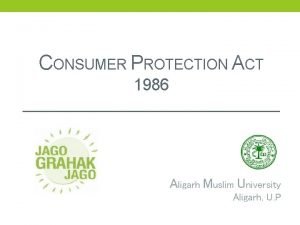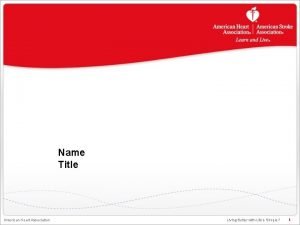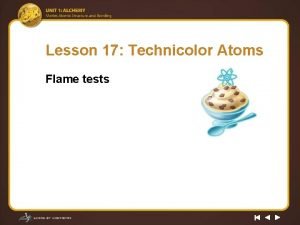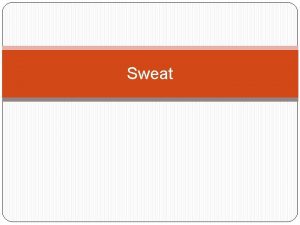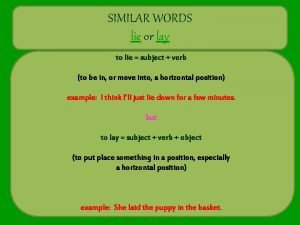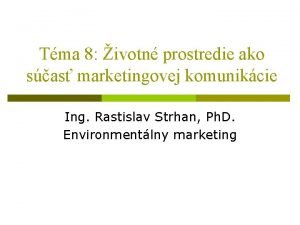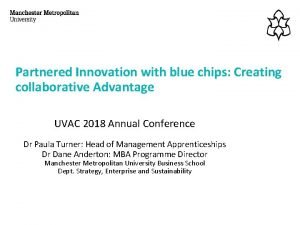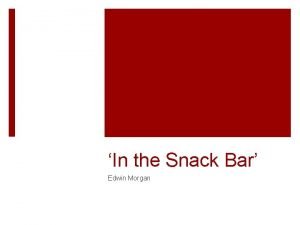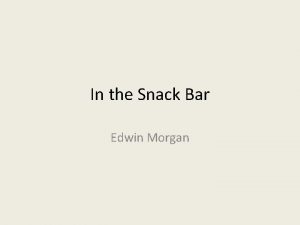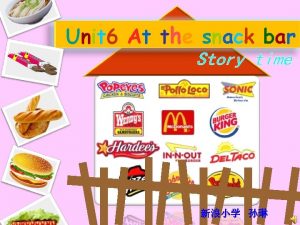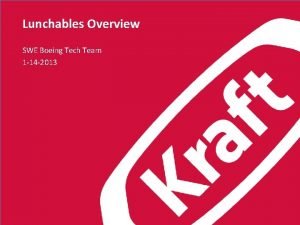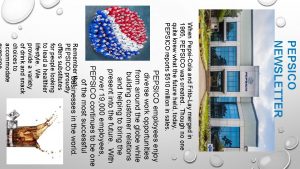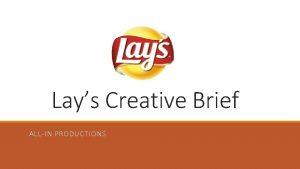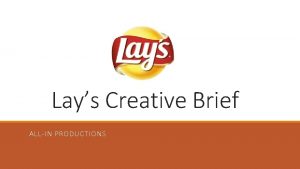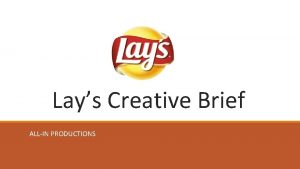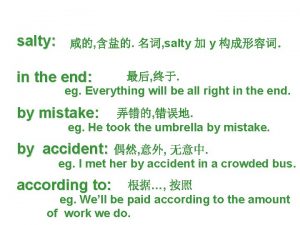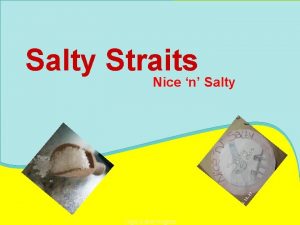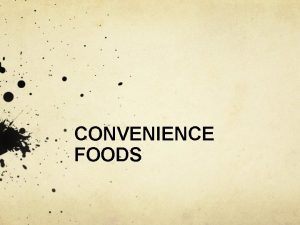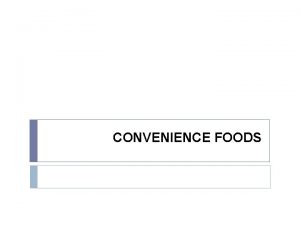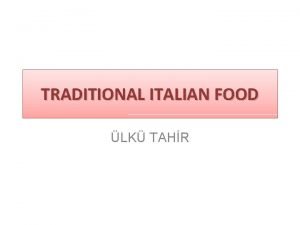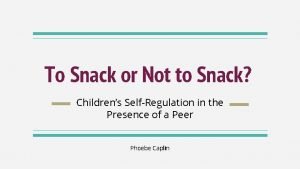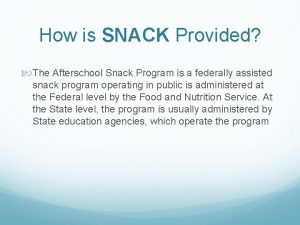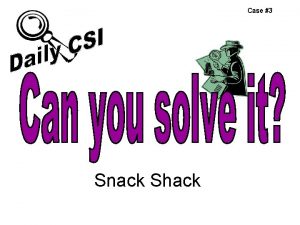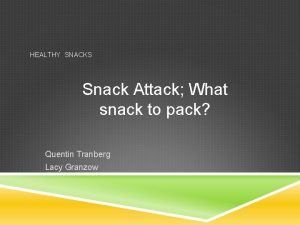WHO IS PEPSICO FRITOLAY salty snack foods Lays
























- Slides: 24

WHO IS PEPSICO? FRITO-LAY – salty snack foods Lays, Doritos, Cheetos, Tostitos, Fritos, Ruffles, Santitas, Sabra, Walkers QUAKER – cereals, rice, pasta Oatmeal, Granola Bars, Aunt Jemima, Capt’n Crunch, Life, Rice-a-Roni BEVERAGES -- carbonated drinks, sports drinks, fruit juices, tea, waters Pepsi, Gatorade, Mountain Dew, Aquafina, Tropicana, Sierra Mist, Mug Has joint ventures with Unilever (Lipton) and Starbucks (coffee), and has a licensing agreement with Dr. Pepper Snapple Group (Dr. Pepper, Snapple, Crush, Schweppes), Dole (pineapple), and Ocean Spray (cranberries). THREE INTERNATIONAL DIVISIONS – Latin America, Europe. Sub-Saharan. Africa (ESSA), Asia. Mid. East. NAfrica (AMENA) Has an international presence in 220 countries.

Convenience Food Competitors in North America Manufacturer Pepsi. Co Kraft Foods Hershey Kellogg Master Foods General Mills Proctor & Gamble Private Label Others Market Share 25 % 12 9 6 5 2 1 7 33 100

Soft Beverages Market in North America Category Gallons (in millions) Carbonated Soft Drinks 14, 707. 4 Bottled Water 8, 822. 4 Fruit Beverages 3, 899. 5 Isotonic Sports Drinks 1. 355. 1 Ready-to-drink Tea 875. 1 Flavored/enhanced water 546. 5 Energy drinks 302. 6 Ready-to-drink Coffee 45. 1 TOTAL 30, 553. 7 Volume Share 48. 1 % 28. 9 12. 8 4. 4 2. 9 1. 8 1. 0 0. 1 100. 0

PEPSI Soft Drinks – Market Shares Country/Region Beverage Market Shares Middle East India Thailand Egypt Venezuela United States Nigeria China Russia 75 % 49 49 47 42 39 38 36 24

PEPSI Salty Snacks – International Market Shares Country/Region Mexico Holland South Africa Australia Brazil India United Kingdom Russia Spain China Snacks Market Shares 75 % 59 57 55 46 46 44 43 41 16

PEPSICO – 22 Top Brands ( > $ billion revenue) Pepsi Cola $ 3. 05 Lays Mountain Dew Gatorade Tropicana Diet Pepsi 7 Up Doritos Quaker Foods Cheetos Mirinda 22. 0 9. 0 7. 5 7. 3 6. 1 5. 65 4. 8 4. 4 3. 5 3. 2 Lipton RTD Teas Ruffles Tostitos Aquafina Pepsi MAX Brisk Sierra Mist Fritos Diet Mountain Dew Starbucks RTD Bevs Walkers $ 2. 75 2. 55 2. 1 1. 75 1. 4 1. 1

Macro/Societal Environment (PEST) POLITICAL - Government regulations regarding greenhouse gas emissions, mergers, etc. - Pending regulations on food snacks & sugar content in children’s food, etc. - Anti-American sentiment; deliberate attempts to limit trade ECONOMIC + Emerging consumer markets with disposable income in China and India - Stagnant/sluggish economic growth – worldwide - Financial instability in some international markets; causing runaway inflation - Currency fluctuations and a very strong US Dollar hurt overseas profits/trade SOCIO-CULTURAL + US residents eat snacks 2 -3 times each day + Societal interest in health, exercise, and organic foods - Consumer interest in reducing intake of sugary drinks and salty snacks - Decline in demand for carbonated beverages in USA TECHNOLOGICAL + Development of better artificial sweeteners (Stevia/Monk Fruit) + Wearable “fitbit” devices to monitor sweating, need for electrolytes, calories

Competitive Environment • RIVALRY – Intense worldwide completion… primarily with Coca-Cola, DPSG, Kellogg, Kraft-Heinz, Mondelez, Monster, Nestle, Red Bull, and Snyder’s-Lance. • SUBSTITUTES – water, coffee, tea, bread, competitor products (Coke, etc) • BARRIERS TO ENTRY/EXIT – government regulation of beverages and food products; access to emerging markets and distribution channels; high capital investment in food processing factories and bottling plants. • CUSTOMER POWER – Very large supermarket chains and Wal. Mart have significant bargaining power. • SUPPLIER POWER – Well-integrated supply chain; many suppliers are dependent/captive.

MARKET STRENGTHS/WEAKNESSES STRENGTHS Well-diversified, large focused brand portfolio; over 100 brands, 22 over $ billion/yr Concentric diversification enables synergy in marketing activities & distribution channels Number 1 in salty snacks worldwide, with a 25% market share in USA Number 1 in beverages in USA (39%) [Note: Coke is # 1 worldwide] Is the number 2 food and beverage company in the world (Nestle is # 1) Has a well-integrated supply chain and distribution network Using solar panels, alternative energy sources, compressed gas vehicles in facilities to curb carbon emissions/footprint Recent acquisitions to enter new markets: Russia’s leading juice company…Lebedyunsky VW Water and True North Nut snacks in UK; Lipton Teas agreement with Unilever Investment in international markets 2016 > $1 billion in China; > $500 million in India WEAKNESSES Too dependent on the US market; over 12% of all sales are with Wal. Mart Hurt by bad publicity over Aquafina scandal, Aunt Jemima and Tropicana recalls International markets have been difficult to develop… some acquisitions have been poor. International profits are badly hurt by currency exchange rates and strong US dollar Some stockholders are pressuring Pepsi. Co to spin off the food divisions from beverages

STRATEGIC ASSESSMENT Through acquisitions, Pepsi. Co grew from primarily a beverage company into the second-largest food and beverage company in the world. Using a concentric-diversification strategy, they acquired businesses which were complimentary to their beverages… notably Frito-Lay (salty snacks), Taco Bell and Pizza Hut restaurants. While they weren’t necessarily experts on how to make pizzas or chips, they did know that they could sell their beverages to these same customers, so marketing and distribution channel synergies were achieved. Pepsi continued to acquire food and snack companies, and built a brand portfolio of over 100 products worldwide… most of which go well with one or more of their beverages. In the 1990’s it became apparent that the fast-food restaurant business was becoming very competitive, and with increasing stockholder pressure, Pepsi spun off its restaurants to YUM Co. (Taco Bell, Pizza Hut, Kentucky Fried Chicken). Since that time, the company has continued to focus on its core businesses… beverages and snack foods. Their current portfolio of products is so extensive that they don’t worry about consumer taste shifts or switching, because most consumers will simply switch from one Pepsi product to another product item owned by Pepsi. Co.

STRATEGIC ASSESSMENT - contd Current plans are to expand into global markets, particularly China and India, where the company will invest $ 1 billion and $500 million, respectively in 2016. Pepsi has also recently acquired the largest juice company in Russia, Lebedyansky, has acquired VW Water and True North Nuts in the UK, and has a new agreement with Unilever to distribute Lipton Tea. This international strategy is risky, given recent problems with currency instability and the strong US dollar. Over the last two years, Pepsi. Co has lost more than $2 billion due to political instability and the devaluation of the Bolivar in Venezuela. This has not only hurt corporate profits, but also threatens the financial stability of the entire firm if it continues (see Altman’s Z). Some new products soon to be introduced include a wearable “fitbit” and patch which monitors sweating and lost electrolytes. The Gatorade division will launch a “smart cap” bottle which senses your seating, and flashes when you need to drink more fluids/Gatorade. Obviously, this is something special for the health/fitness/athletic population.

STRATEGIC ASSESSMENT - contd Another product soon to be launched is ready to drink cold-brewed coffee. In partnership with Starbucks, Pepsi. Co will distribute in the US, and hopes to introduce it to China by the end of the year. By adding ginseng, taurine, acai berry, and guarana flavors to the brew, it is expected to have particular appeal in the Chinese market. Finally, Quaker Oats division is introducing a new product called Breakfast Flats, which is a type of crispy breakfast food particularly aimed at working women who are on the run. It will come in several flavors, cranberry/almond, banana honey-nut, and golden raisin/cinnamon. Test market results have been quite positive. In summary, Pepsi. Co continues to follow a strategy of growth through concentration and concentric diversification. They continue to add products that compliment their existing brands/lines, and they are actively trying to expand their market presence globally through acquisitions, mergers, and partnership agreements.

COMMON SIZE INCOME STMT - PEPSICO (in millions $) Frito-Lay North America Quaker Oats N America North America Beverages Latin America Europe/Sub. Sahara. Africa Asia/Mid. East/North. Africa OPER REVENUE Cost of Sales 2015 14782 2543 20618 8228 10510 6375 63056 23. 4 4. 0 32. 7 13. 0 16. 7 10. 1 100 2013 14126 2612 20083 9335 13828 6431 66415 2007 11586 1860 10230 21. 3 3. 9 30. 2 14. 1 20. 8 9. 7 100 29. 4 4. 7 25. 9 *15798 40. 0 39474 100 GROSS PROFIT Selling/Gen/Admin Exp Venezuela Impairment Costs Amortization Intangible Assets 28384 34672 24885 1359 75 45. 0 55. 0 39. 5 2. 2 0. 1 31243 35172 25357 --110 47. 0 53. 0 38. 2 --0. 2 18038 21436 14208 45. 7 54. 3 36. 0 58 0. 1 OPERATING PROFIT 8353 13. 2 9705 14. 6 7170 18. 2 Interest Other Income or (Expense) Income Before Tax 970 59 7442 1941 1. 5 0. 1 11. 8 3. 1 911 97 8891 2104 1. 4 0. 1 13. 4 3. 2 224 685 7631 1973 0. 6 1. 7 19. 3 5. 0 NET INCOME 5501 8. 7 6787 10. 2 5658 14. 3

PROFITS by DIVISION -- PEPSICO (in millions $) DIVISION 2015 Profit %/Total Frito-Lay NA 4304 51. 5 Quaker Oats NA 560 6. 7 NA Beverages 2785 33. 3 International Latin America - 206 - 2. 4 Europe/SSAfrica 1081 12. 9 Asia/ME/NAfrica 941 11. 3 Corporate- 1112 - 13. 3 - 1453 Operating Profit 8353 100 2013 Profit %/Total 2007______ Profit %/Total 3877 617 2580 39. 9 6. 4 26. 6 2845 568 2188 2322 1617 1327 1140 - 15. 0 16. 7 13. 7 11. 7 - 753 9705 100 39. 7 7. 9 30. 5 32. 4 - 10. 5 7170 100

PEPSICO (in millions $) 2015 2013 NET INCOME 5501 Net Income/Share $3. 71 $4. 37 Dividends/Share $2. 7625 74. 4% $2. 24 Stock Price/Share (at year end) $99. 92 $82. 94 8. 7 6787 2007 10. 2 5658 14. 3 $3. 48 51. 3% $1. 42 $77. 32 40. 8%

COMMON SIZE BALANCE SHEET – PEPSICO (in millions $) 2015 2013 2007 Cash Invest Securities Receivables Inventory Other Curr Assets TOT CURR ASSET Equipment (net) Other Property/Asset TOTAL ASSETS 9096 2913 6437 2720 1865 23031 16317 30319 69667 13. 1 4. 2 9. 2 3. 9 2. 7 33. 1 23. 4 43. 5 100 9375 303 6954 3409 2162 22203 18575 36700 77478 12. 1 0. 4 9. 0 4. 4 2. 8 28. 7 24. 0 47. 3 100 910 1571 4389 2290 991 10151 11228 13249 34628 2. 6 4. 5 12. 7 6. 6 2. 9 29. 3 32. 4 38. 3 100 Current Liabilities 17578 LT Debt+Leases 29213 Other Liabilities 10846 TOT LIABILITIES 57637 Stockholder Equity 12030 TOTAL LIAB & SE 69667 25. 2 41. 9 15. 6 82. 7 17. 3 100 17839 24333 10917 53089 24389 77478 23. 0 31. 4 14. 1 68. 5 31. 5 100 7753 4203 5438 17394 17234 34628 22. 4 12. 1 15. 7 50. 2 49. 8 100

CASH FLOW STATEMENTS - PEPSICO (in millions) 2015 2013 2007 Note: Net Income was… CASH PROVIDED FROM OPERATIONS 5501 6787 5658 10580 9688 6934 CASH PROVIDED FROM INVESTING (3569) (2625) (3744) CASH PROVIDED FROM FINANCING (3828) (3789) (4006) Exchange Rate Changes ( 221) ( 196) 75 (Decrease)Increase FY 2962 3078 ( 741) Cash @ Beginning Cash @ End of Year 6134 9096 6297 9375 1651 910

FINANCIAL ASSESSMENT PEPSICO 2015 2013 2007 Current Ratio (CA/CL) 1. 31 1. 24 1. 30 Tot Liabilities/Tot Assets Tot Liabilities/SEquity . 827 4. 791 . 685 2. 177 . 502 1. 009 Inventory Turnover (COGS/Invent) 10. 44 9. 165 7. 877 Avg Collection Period (ARx 365/Sale) 37. 3 dys 38. 2 dys 40. 6 dys Asset Turn (Sales/TA). 905. 857 1. 140 Net Profit (NI/Sales) ROA (NP/TA) . 0872. 0790 . 1022. 0876 . 1433. 1634 Altman’s Z 1. 76 2. 05 3. 20

FINANCIAL TRENDS POSITIVE TRENDS Cash is increasing Revenue + profits are up for Frito-Lay and NA Beverages Dividends have been increased WORRISOME TRENDS Revenue + profits are down in all international divisions Big problem in Venezuela… impairment costs > 2 Billion/2 yrs Operating profits and Net profit are both down Long-term debt is up; Debt/Asset ratio is too high Stockholder Equity is way down…why? Interest expense is up Altman’s Z is getting critically low…

SCENARIO 1 - PESSIMISTIC OUTLOOK Over the next three to five years, the world economy remains stagnant, with little disposable income growth. England exits the European Union, creating more economic and financial uncertainty. Interest rates creep up as the US Federal Reserve raises concerns about inflation. The US dollar remains strong relative to other currencies, creating more currency fluctuations and uncertainties for US companies. Disputes with China and Russia continue to muddle trade growth with those countries. The public interest in exercise and health grows, and laws are passed banning sugar in sodas and limiting salt in snacks, especially for children. Sales of carbonated soft drinks in the US continue to decline. Demand remains very modest for fruit juices, energy drinks and snacks, and natural sweeteners. Coke overtakes Pepsi in the North American soft drink market, and Dr. Pepper launches a snack foods division to compete with Frito-Lay.

SCENARIO 2 – OPTIMISTIC OUTLOOK Over the next three to five years, the world economy rebounds significantly, with notable gains in income and trade. Interest rates remain low, as a new Republican administration takes control of the US Federal Reserve. The US dollar remains relatively strong compared to other currencies, but currency fluctuations diminish and uncertainties in the European Union subside as England decides to stay in the Eurozone. China and Russia enact favorable legislation that encourages foreign investment and trade growth. The public interest in exercise and health continues to grow, and demand for healthy snacks, energy drinks, fruit juices and natural sweeteners explodes. Sales of carbonated soft drinks stabilize in the US, and show signs of increasing growth in Brazil, China, and Russia. The RTD coffee market in China expands rapidly, as ginseng and acai berry flavors really catch on with the public. Pepsi maintains its dominance in the North American soft drink market, and Quaker Oats Breakfast Flats is a big hit with the working women in the USA. Dr. Pepper launches a snack foods division, but only gains a 1. 5% market share.

SCENARIO 3 – MOST LIKELY OUTLOOK Over the next three to five years, the world economy rebounds gradually, and disposable income increases modestly worldwide. Interest rates remain relatively low, as fears of inflation ease. The US dollar remains relatively strong compared to other currencies, but currency fluctuations and uncertainties continue, with the departure of England from the European Union. Trade with China continues to muddle along, as their economy switches over from an export economy to domestic consumption. Trade growth with Russia continues to be impaired because of ongoing disputes over the Ukraine and Russia’s involvement in the Syrian conflict. While there is public interest in exercise and health, no legislation is enacted about sugary drinks or salty snacks. A notable segment of the population wants healthy snacks, energy drinks, fruit juices and natural sweeteners, so that market is expected to grow in the US. Sales of carbonated soft drinks stabilize in the US, and soft drinks and the RTD coffee market in China are expected to grow significantly. Pepsi will maintain its dominance in the North American soft drink market, but their international divisions will continue to face difficulties and market challenges.

KEYS TO SUCCESS – A Comparison PEPSI Coca-Cola Dr. Pepper/Snapple Broad Product Portfolio 8 5 6 New Products Introduced 6 7 5 Efficient Operations 8 8 7 Strong Marketing/Sales 8 9 6 Good Distribution Channels 8 9 6 International Market Share 8 7 6

STRATEGY – For the Next 3 -5 Years Continue to find/acquire/launch new products which fit concentrically with Pepsi’s existing portfolio of brands. Launch the healthy snacks and drinks, and start using stevia and other natural sweeteners which appeal to the health-conscious public. Consider exiting markets where the economy is in chaos, like Venezuela. This operation has cost the company $2 billion in lost profits over the past few years. Maybe this is a place we don’t need to be, even if we have a 42% market share there. Cautiously pursue the China market. Certainly it has huge potential, but will the RTD coffee be a big hit? There is plenty of room to grow both traditional soft drinks and salty snacks in China, where we currently have just 36% of the soft beverages and only a 16% of the salty snacks market. Reduce long-term debt, which seems to be a burden the company doesn’t need right now, given the uncertainty in the international marketplace. Keep the North American beverages and snacks divisions healthy, and try to improve performance in the international divisions.
 Bcg matrix of pepsico
Bcg matrix of pepsico Space matrix of pepsico
Space matrix of pepsico Krishnan kumar bajaj vs pepsico
Krishnan kumar bajaj vs pepsico Bcg matrix of pepsico
Bcg matrix of pepsico Ma trận qspm của pepsi
Ma trận qspm của pepsi Bcg matrix of pepsico
Bcg matrix of pepsico Salty brigade
Salty brigade Aha salty six
Aha salty six Lesson 17 technicolor atoms flame test worksheet answers
Lesson 17 technicolor atoms flame test worksheet answers Sound of a word
Sound of a word Salty liquid
Salty liquid Salty sour
Salty sour Lays mascot
Lays mascot Lays vs lies
Lays vs lies Lays mascot
Lays mascot High-level format of disk lays down
High-level format of disk lays down Aapacs
Aapacs Advantage and disadvantage of lays chips
Advantage and disadvantage of lays chips Campesinas lay's
Campesinas lay's Dikda
Dikda High- level format of disk lays down:
High- level format of disk lays down: Snack bar poem
Snack bar poem A cup capsizes along the formica
A cup capsizes along the formica Snack 可數
Snack 可數 Lunchable snack duos
Lunchable snack duos


